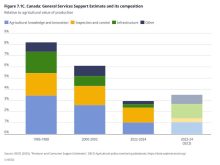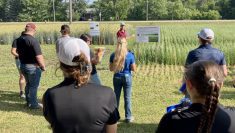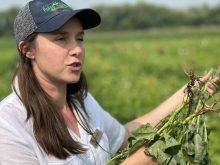Three products made from urban wastes show promise as organic fertilizers — and as ways to cycle nutrients from the city back to the farm, a University of Manitoba study shows.
“It’s really important that we start the conversation about having a circular food system rather than a linear food system,” said Jessica Nicksy, a master’s student in soil science at the University of Manitoba.
“We should be thinking about how the waste product of one process in the food system can become an input to another rather than a harmful waste.”
Read Also

Local farm businesses, groups look forward to Manitoba Ag Days 2026
Most of agriculture is seemingly at Manitoba Ag Days each January: Manitoba agribusinesses and farm groups look forward to connecting with farmers at the 2026 show.
Why it matters: As one professor said, Winnipeg is the largest feedlot in Manitoba, but its ‘manure’ goes into the landfill or wastewater.
In 2019 and 2020, Nicksy studied the effects of three products as phosphorus fertilizers. Struvite is made by precipitating phosphorus out of municipal or animal wastewater. Anaerobic digestate is made when food waste is processed in the absence of oxygen. Frass is the residue from feeding restaurant and grocery store waste to black soldier fly larvae.
With frass, the larvae are used as high-protein animal food. The process of making digestate also produces biogasses which can be used to generate electricity.
Nicksy applied these to wheat and alfalfa and compared results to a control with no amendment, conventional mono-ammonium phosphate and aerobic compost.
All were applied to the wheat at 20 kg of phosphorus per hectare (about 8 kg/ac).
Preliminary results showed that all three outperformed the control in terms of wheat yield. However, frass performed almost on par with conventional fertilizer. In 2019, the frass plots produced around 3500 kg/ha (about 52 bu/ac) and conventional fertilizer produced only slightly more.
“That actually kind of blew me away,” Nicksy said.
Digestate produced about 3000 kg/ha or 45 bu./ac.

Struvite showed the least response in wheat at just over 2500 kg/ha or 37 bu./ac., which was just above the control. Nicksy said is likely due to its low solubility in water. In her alfalfa plots, struvite also showed little result in the first year but “humongous” improvement the second year.
“I think the takeaway is that these are all viable phosphorus sources,” Nicksy said.
She added that she and professor Martin Entz decided to incorporate frass and digestate into the long-term organic/conventional rotation studies at the university’s Glenlea research station.
These three products, while all commercially available, remain quite niche. This and other studies out of the University of Manitoba are some of the first on the Prairies, Nicksy said.

Most of the literature she reads on them comes from Europe where stricter laws and agricultural strategies make them more popular options.
A lot of buy-in from several sectors is needed to make recycled nutrient products economically viable, Nicksy added, but it’s a conversation that must be started.
“Even in conventional farming we’re going to run out (of minable phosphorus) one day,” said Nicksy. “It might be sooner than you think, particularly if we don’t get better at recycling phosphorus within the food system.”
These types of processes also keep waste out of the landfill where it can contribute to greenhouse gas emissions, or out of wastewater where it can run downstream and cause toxic algal blooms.
People could think of themselves as ‘animals’ in the food system and their waste not unlike the manure farmers use on fields.
“My professor, Martin Entz, likes to say that Winnipeg is the largest feedlot in Manitoba,” Nicksy said. “Often when we think about sustainability in the food system we think of ourselves as something somehow removed and other from it, that we don’t exist within the food system — but we do.”
















